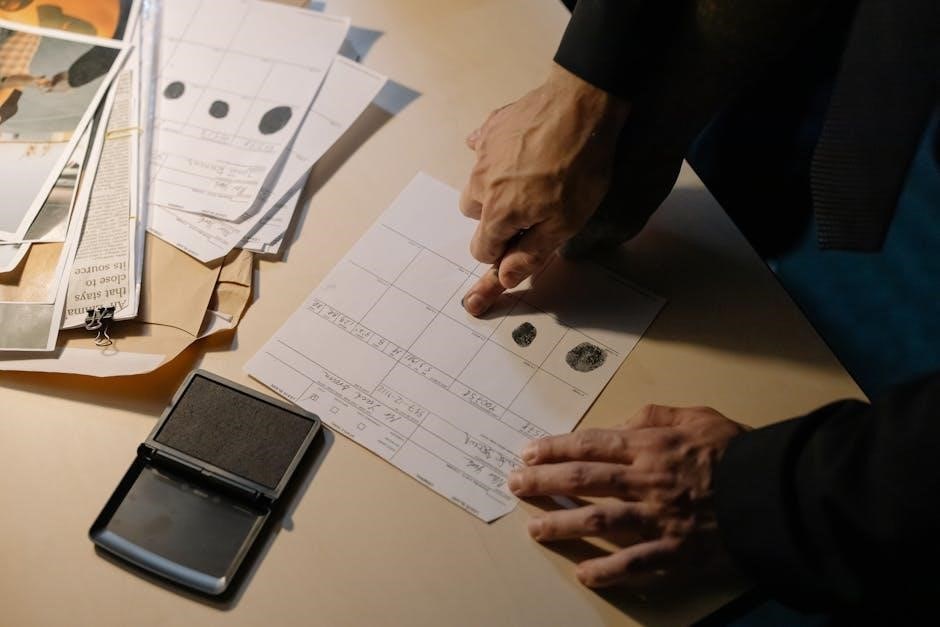the case for christ study guide
This study guide, inspired by Lee Strobel’s investigative journey, explores historical and biblical evidence for Jesus Christ’s life, death, and resurrection, equipping believers to share their faith confidently.
1.1 Overview of the Study Guide
The “Case for Christ Study Guide” is a comprehensive resource designed to help participants explore the evidence for Jesus Christ’s life, death, and resurrection. Based on Lee Strobel’s investigative approach, the guide examines historical records, archaeological findings, and expert testimonies to build a compelling case for Christianity. It is structured to facilitate group discussions, personal reflection, and a deeper understanding of the biblical narrative. The study guide is ideal for believers seeking to strengthen their faith and for skeptics interested in examining the evidence. By combining logical inquiry with spiritual insights, it provides a balanced approach to understanding the claims of Christ.
1.2 Target Audience and Purpose
The “Case for Christ Study Guide” primarily targets Christians seeking to deepen their understanding of their faith and skeptics exploring Christianity. Its purpose is to provide evidence-based discussions, helping believers articulate their faith confidently and equipping seekers with factual insights. By addressing common questions and doubts, the guide aims to foster spiritual growth and apologetic confidence. It serves as a tool for small groups, churches, and individuals eager to engage with the evidence supporting Jesus Christ’s life and teachings, ensuring participants are well-equipped to discuss their beliefs with clarity and conviction in an increasingly questioning world.
1.3 Course Objectives and Outcomes
The course aims to equip participants with a deeper understanding of the historical and biblical evidence supporting Jesus Christ. It seeks to enhance critical thinking and faith articulation. By examining expert testimonies, archaeological findings, and scriptural reliability, students gain confidence in discussing their beliefs. The study guide fosters spiritual growth, encouraging participants to apply the evidence in daily life and share their faith effectively. Upon completion, learners are expected to articulate key apologetic arguments, address common objections, and integrate biblical truths into their personal and relational contexts, ultimately strengthening their faith foundation and evangelistic efforts.

Author Background: Lee Strobel
Lee Strobel, a former atheist and investigative journalist, explores Christianity through evidence-based inquiry in his book “The Case for Christ,” bridging journalism and faith seamlessly.
2.1 Lee Strobel’s Personal Journey from Atheism to Faith
Lee Strobel, once a committed atheist, embarked on a transformative journey to disprove Christianity. His investigative skills, honed as a journalist, led him to explore historical evidence. Through meticulous research into eyewitness accounts, archaeological findings, and expert testimonies, Strobel encountered compelling proof of Jesus Christ’s life, death, and resurrection. This evidence challenged his skepticism and led him to embrace Christianity. His personal journey from doubt to faith serves as a powerful example of how intellectual curiosity and evidence-based inquiry can lead to spiritual transformation. Strobel’s story resonates with seekers and believers alike, offering a relatable path from skepticism to conviction.

2.2 Strobel’s Investigative Approach to Christianity
Lee Strobel’s investigative approach to Christianity was rooted in his journalistic training. He applied rigorous scrutiny to biblical claims, treating them like a legal case. By cross-examining historical records, interviewing scholars, and analyzing scientific evidence, Strobel sought to verify the validity of Christian teachings. His methodical process included assessing non-Christian sources, archaeological findings, and the reliability of eyewitness accounts. This systematic investigation allowed him to address doubts and objections critically. Strobel’s approach demonstrates how a skeptical mindset, when coupled with thorough research, can lead to a deeper understanding and acceptance of faith.
2.3 The Impact of “The Case for Christ” Book
Lee Strobel’s The Case for Christ has become a cornerstone of Christian apologetics, inspiring millions to explore the evidence for Jesus. Its clear, investigative style has made it accessible to skeptics and believers alike. The book has been translated into multiple languages, reaching a global audience. Many churches and study groups use it as a resource to deepen faith and address doubts. Its influence extends beyond individual readers, shaping Christian apologetics and encouraging others to investigate the validity of the Gospel accounts. The book’s impact lies in its ability to bridge faith and reason, providing a compelling case for Christianity.

Historical Evidence for Jesus Christ
This section examines the historical validations of Jesus Christ, including non-Christian sources, archaeological evidence, and eyewitness accounts, strengthening the biblical narrative and its credibility.
3.1 Non-Christian Sources and Their Testimony
Non-Christian sources provide significant testimony supporting the historical existence of Jesus Christ. Flavius Josephus, a Jewish historian, mentions Jesus and His followers in his writings. Tacitus, a Roman historian, references Jesus’ crucifixion under Pontius Pilate. Similarly, Pliny the Younger and Thallus also allude to Jesus or early Christian events. These non-biblical accounts corroborate key details of Jesus’ life and impact, offering independent verification of His existence and influence. Such testimonies are crucial in building a case for Christ, as they demonstrate that belief in Jesus is not solely based on Christian texts but is supported by external historical records.
3.2 Archaeological Evidence Supporting the Bible

Archaeological discoveries have consistently validated numerous biblical accounts, providing tangible evidence that supports the historical reliability of Scripture. For instance, the unearthing of the Pool of Siloam, referenced in John 9:7, confirms the existence of this ancient site. Similarly, the Taylor Prism, which details the fall of Samaria, aligns with biblical records in 2 Kings 15:29. Such findings corroborate the Bible’s historical accuracy. Additionally, inscriptions like the Pilate Stone, mentioning Pontius Pilate, and the Caiaphas Ossuary, linked to the high priest, further authenticate the New Testament narrative. These archaeological confirmations strengthen the case for the Bible’s trustworthiness and the historical foundation of Christianity.
3.3 The Role of Eyewitness Accounts
Eyewitness accounts play a pivotal role in verifying the life, death, and resurrection of Jesus Christ. The New Testament narratives, particularly the Gospels, are rooted in the testimonies of those who directly witnessed these events. Lee Strobel emphasizes the credibility of these accounts, noting that the disciples and early followers of Jesus risked persecution and death to share their experiences. Psychological evaluations of these witnesses, as explored in the study guide, suggest that their testimonies exhibit characteristics of truthfulness, such as consistency and emotional authenticity. Additionally, the accounts of non-Christian observers further corroborate the historical events, providing a robust foundation for the case for Christ.

The Resurrection of Jesus
The Resurrection of Jesus is a cornerstone of Christian faith, supported by the empty tomb, archaeological evidence, and expert testimonies, as explored in Lee Strobel’s guide.
4.1 The Empty Tomb: Historical and Archaeological Perspectives
The empty tomb is a pivotal piece of evidence for Jesus’ Resurrection, supported by historical accounts and archaeological findings. The Gospels describe the tomb as discovered empty by women, with Roman guards absent, and the stone rolled away. Archaeological research confirms the location of the Garden Tomb in Jerusalem aligns with biblical descriptions. Historical records, including those from non-Christian sources like Josephus Flavius, corroborate the existence of Jesus and the empty tomb. Expert testimonies highlight the tomb’s state, suggesting no natural explanation for its emptiness. This evidence strengthens the case for the Resurrection, making it a cornerstone of Christian apologetics.
4.2 Post-Resurrection Appearances: Eyewitness Testimony
The Resurrection is further validated by multiple eyewitness accounts of Jesus’ post-death appearances. The New Testament records encounters with Jesus by His disciples, including Peter, John, and Thomas, as well as over 500 people at once. These testimonies, documented in 1 Corinthians 15:5-7, emphasize the transformative impact of these events. The credibility of these accounts is strengthened by the willingness of early followers to endure persecution and death for their belief in the risen Christ. Scholarly analysis highlights the reliability of these narratives, as they reflect personal experiences rather than mythical or fabricated stories. These accounts form a cornerstone of Christian faith, offering compelling evidence for the Resurrection.
4.3 Alternative Explanations for the Resurrection
While the Resurrection is a cornerstone of Christian faith, alternative explanations have been proposed to account for the empty tomb and post-resurrection appearances. Skeptics suggest theories like the “swoon theory,” where Jesus survived the crucifixion, or the “stolen body” hypothesis, implying disciples took His body. Others propose hallucinations due to grief or mass hysteria. However, these theories face significant challenges. The swoon theory contradicts historical accounts of Roman crucifixion’s brutality, while the stolen body theory lacks evidence and credibility. Hallucinations are unlikely given the consistent, detailed testimonies of multiple eyewitnesses. Lee Strobel and scholars argue these alternatives fail to explain the transformative impact of the Resurrection on early followers, reinforcing its historical validity.

Expert Testimonies and Contributions
Lee Strobel consults scholars, theologians, and experts from various fields, providing a comprehensive analysis of evidence supporting Christ’s resurrection and divinity, enhancing the study guide’s credibility.
5.1 Interviews with Scholars and Theologians
Lee Strobel engages in in-depth interviews with renowned scholars and theologians, offering insights into the historical and theological underpinnings of Christianity. Experts in archaeology, manuscript analysis, and biblical history provide evidence supporting the reliability of the Gospels. Strobel’s legal background ensures rigorous questioning, creating a balanced and unbiased exploration. These interviews highlight the credibility of eyewitness accounts and the supernatural claims surrounding Jesus’ resurrection. Scholars like Craig Blomberg and Michael Licona address key questions, offering well-researched responses to common criticisms. Their contributions provide a strong foundation for understanding the evidence behind Jesus’ divinity and the validity of the Christian faith.
5.2 The Role of Science and Psychiatry in Verifying the Resurrection
Lee Strobel examines the resurrection through scientific and psychiatric lenses, exploring natural explanations for the empty tomb and post-resurrection appearances. Medical experts assess the likelihood of Jesus surviving crucifixion, while psychiatrists evaluate the mental state of eyewitnesses. Strobel consults with experts like Dr. Alexander Metherell, who explains the physical impossibility of surviving such torture. Psychiatric evaluations suggest that hallucinations or mass hysteria are unlikely explanations for the consistent testimonies of Jesus’ followers. This section bridges faith and reason, demonstrating how science and psychology support the historical authenticity of the resurrection, providing a compelling case for its validity.
5.3 Contributions of Non-Christian Scholars

Non-Christian scholars play a significant role in verifying the historical accuracy of the New Testament. Experts like Dr. Edwin Yamauchi and Dr. John McRay, though not Christians, provide insights into the reliability of biblical accounts. Their research often aligns with Christian claims, strengthening the case for Christ. For instance, Jewish scholar Dr. Paul Maier acknowledges the historical Jesus and the plausibility of the resurrection. These scholars’ contributions highlight the interdisciplinary nature of Christian apologetics, demonstrating that the evidence for Christ transcends religious affiliation. Their involvement adds credibility to the study guide, showing that the case for Christ is rooted in verifiable history and evidence accessible to all.

The Reliability of the Gospels
The Gospels are supported by strong manuscript evidence, early dating, and archaeological confirmation, ensuring their historical accuracy and trustworthiness as records of Jesus’ life and teachings.
6.1 The Authorship and Date of the Gospels
The Gospels are traditionally attributed to eyewitnesses or their close associates, such as Matthew, John, and Peter’s companion Mark. Scholars date them to the 1st century, with some portions, like the Passion Narrative, potentially circulating earlier. Archaeological evidence supports the plausibility of early composition, aligning with the lives of the apostles. The lack of significant theological development suggests a timeframe close to Jesus’ ministry. This early dating strengthens the Gospels’ credibility as reliable historical records, bridging the gap between Jesus’ life and the written accounts. Their authorship and date are critical to understanding their historical reliability and trustworthiness.
6.2 Manuscript Evidence and Textual Reliability
The New Testament boasts an unprecedented wealth of manuscript evidence, with over 5,800 Greek manuscripts and numerous early translations. The earliest fragments, such as P52 (circa 125 AD), confirm the textual stability of the Gospels. Despite minor variations, the core message remains consistent, underscoring the reliability of the text. Advanced textual criticism techniques further validate the authenticity of the manuscripts, demonstrating that the Gospels have been faithfully preserved. This extensive manuscript support is unparalleled in ancient literature, providing strong assurance of the Gospels’ textual integrity and reinforcing their historical trustworthiness.
6.3 Contradictions and Alleged Discrepancies
The study guide addresses apparent contradictions in the Gospels, such as differences in resurrection accounts, to demonstrate their harmonization. Scholars explain that minor variations often stem from unique eyewitness perspectives, not factual errors. For example, the resurrection narratives in Matthew, Mark, Luke, and John differ in detail but align in their central message. These discrepancies, far from undermining the Gospels, highlight the authenticity of independent eyewitness accounts. Strobel examines how most alleged contradictions disappear upon closer examination, reinforcing the texts’ reliability and the eyewitnesses’ credibility. This section equips readers to confidently address common objections to the Gospels’ accuracy.

Personal Journey and Application
This section guides participants in applying the evidence for Christ to their personal lives, fostering spiritual growth and confidence in sharing their faith with others effectively.
7.1 Sharing Your Faith with Confidence
This section equips participants with practical strategies to share their faith effectively, emphasizing the importance of evidence-based discussions. By understanding the historical reliability of the Gospels and the resurrection, believers gain confidence in presenting the truth of Christianity. The study guide encourages fostering meaningful conversations, addressing common objections, and relying on expert testimonies to strengthen their message. Lee Strobel’s personal journey from skepticism to faith serves as a powerful example of how evidence can transform lives; Participants are inspired to approach evangelism with empathy and clarity, ensuring their faith is shared in a way that resonates with others. This section empowers individuals to articulate their beliefs boldly and compassionately.
7.2 Applying the Evidence in Daily Life
This section focuses on integrating the evidence for Christ into daily living, helping believers connect their faith to real-life challenges. Participants explore how historical and scientific proofs strengthen their personal relationship with God. Practical applications include using biblical truths to guide decision-making, foster resilience, and inspire ethical living. The study guide emphasizes the relevance of apologetics in navigating modern dilemmas, while encouraging a deeper walk with Christ. By applying the evidence, individuals find purpose and confidence in their faith, transforming their everyday experiences into opportunities for spiritual growth and impactful living. This section bridges the gap between theology and practical Christian living, making faith a daily reality.
7.3 Encouraging Others to Explore Christianity
This section equips believers to share their faith effectively, using evidence from the study guide to engage others in meaningful conversations. By leveraging personal testimonies, historical proofs, and biblical truths, individuals can inspire curiosity and openness to Christianity. The guide emphasizes the importance of active listening and empathy, encouraging believers to address questions and doubts with compassion. Practical strategies include sharing personal experiences, recommending resources, and fostering a safe, judgment-free environment for exploration. The goal is to empower Christians to confidently invite others to consider the evidence for Christ, trusting the Holy Spirit to work in their hearts. This approach creates ripples of faith in communities and beyond.
The study guide concludes by reinforcing the compelling evidence for Jesus Christ, encouraging believers to deepen their faith and confidently share the truth with others.
8.1 Key Takeaways from the Study Guide
The study guide emphasizes the historical reliability of the Gospels, the evidence supporting Jesus’ resurrection, and the credibility of eyewitness accounts; It highlights expert testimonies from scholars, scientists, and theologians, offering a well-rounded perspective on Christian apologetics. Participants gain confidence in sharing their faith by understanding the factual basis of Christianity. The guide also encourages applying biblical truths in daily life and inspiring others to explore Jesus’ identity. Ultimately, it equips believers with tools to defend their faith intelligently, fostering spiritual growth and a deeper connection with Christ.
8.2 The Ongoing Relevance of Christian Apologetics
Christian apologetics remains vital in addressing modern skepticism and cultural challenges. It equips believers to defend their faith intelligently, bridging the gap between faith and reason. By addressing tough questions and doubts, apologetics fosters a deeper understanding of Christianity’s foundational truths. It also plays a crucial role in evangelism, helping to make the Gospel more accessible and relatable to those seeking answers. In an age of diverse worldviews, apologetics encourages believers to think critically and share their faith with confidence. Ultimately, it strengthens the church by providing a solid intellectual and spiritual foundation for discipleship and growth, ensuring the timeless message of Christ remains relevant in every generation.
8.3 Resources for Further Study and Growth
For deeper exploration, the study guide recommends additional books like The Case for the Real Jesus and The Case for Faith, offering insights into specific aspects of Christian apologetics. Online courses, such as those on biblical archaeology or theology, provide further learning opportunities. Joining Bible study groups or attending apologetics conferences can enhance understanding and application of the material. Supplementary resources include DVDs, study guides, and digital tools to aid personal reflection and group discussions. These materials empower learners to continue their spiritual journey, equipping them with knowledge and confidence to share their faith effectively in an ever-changing world.

